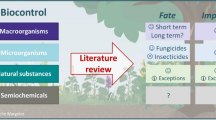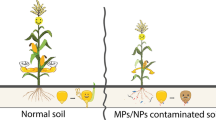Abstract
Polythene tubes are the most commonly used seedling containers and their adoption can be attributed to high water retention that enhances seedling establishment as well as the desire for low-cost readily-available containers by nursery operators. Polythene tubes have drawbacks, however, because they adversely affect seedling root growth and are an environmental hazard. This study was conducted in Meru, Eastern Kenya, to investigate whether small-scale tree nursery operators are likely to adopt biodegradable seedling containers (cellulose papers and banana sheaths). It was hypothesised that biodegradable containers are better for seedling growth and are more environmental friendly than the widely used polythene bags. The study assessed the frequency of watering and growth (height and basal diameter) of Calliandra calothyrsus seedlings produced in various biodegradable containers under three conditions with varying watering requirements, i.e. light tree shade, shade net and polythene chambers, the first being widely used by farmers. The performance of these seedlings was later monitored in the field. Seedlings produced in biodegradable containers required more frequent watering than those in polythene bags under light tree shade and shade nets but less frequent in polythene chambers. Seedlings produced in polythene tubes had higher growth rates in the nursery, but when transplanted to the field, they were overtaken by those grown in the biodegradable containers due to transplanting shock after the polythene containers were removed. Biodegradable seedling containers can therefore be adopted in areas where water is not very limiting, and evaporation rates could be reduced and water-use efficiency improved by raising seedlings in simple polythene structures.







Similar content being viewed by others
Notes
The biodegradable materials EP, FP and VP are part of the Ellepot System produced by Ellegard A/S (company) of Denmark. Type EP and FP are papers with holes that are glued in such a way that the holes remain open. They consist of cellulose with polyester for enforcement. Type EP is designed to decompose in 8–12 months while type FP is lighter and is designed to decompose in 4–6 months. Type VP is polyester/viscose non-woven paper without holes that is expected to decompose in over 12 months.
Watering tests conducted prior to the experiment showed the field capacity of the substrate was about 150 ml at first watering in the 4 in. × 6 in. polytube and the available water was about 80 ml at C. calothyrsus wilting point. It was therefore estimated that 100 ml of water would be sufficient per seedling to compensate for the lost water and correct for any lack of uniformity between the seedlings as the excess water would drain off.
References
Adane L, Muleta D (2011) Survey on the usage of plastic bags, their disposal and adverse effects on environment: a case study in Jimma City, Southwestern Ethiopia. J Toxicol Environ Health Sci 3(8):234–248
Agyei-Dwarko D, Ofori K (2009) Effect of different moisture and shade regimes on the growth of D × P ex Kusi oil palm seedlings. J Ghana Sci Assoc 11(1):75–84
Anwar A, Mahmood T, Bilqees B (2002) Development of bio-decomposable (jiffy) pots for raising and transplanting nursery plants. nt J Agric Biol 2(4):380–381
Bassman JH, Black RA, Wang XQ (1989) Effect of container type and watering regime on early growth of Western Larch seedlings. Tree Planters’ Notes 40(3):13–15
Campbell KA, Hawkins CD (2004) Effect of seed source and nursery culture on paper birch (Betula papyrifera) uprooting resistance and field performance. For Ecol Manag 196(2–3):425–433
Cedamon ED, Mangaoang EO, Gregorio NO, Pasa AE, Herbohn JL (2004) Nursery management in relation to root deformation, sowing and shading. In: Harrison SR, Herbohn JL, Suh J, Mangaoang E, Vanclay J (eds) Proceedings from the ASEM/2000/088 end of project workshop. The University of Queensland, Brisbane, pp 293–300
Chunmei Z, Qingcheng W, Xiangwei C (1994) Study on relationships among seedling quality and survival rate, stocking percentage and growth. J For Res 5(2):37–45
Franzel S, Wambugu C, Tuwei P (2003) The adoption and dissemination of fodder shrubs in central Kenya. Agricultural research and extension network (AGREN), network paper no. 131
Gerlach L (2007) Cowpots: biodegradable pots for seedlings. http://blisstree.com/live/cowpots-biodegradable-pots-for-seedlings/, Accessed March 2011
Jaenicke H (1999) Good tree nursery practices: practical guidelines for research nurseries, International Centre for Research in Agroforestry (ICRAF). Nairobi, Kenya
Jaetzold R, Schmidt H, Hornetz B, Shisanya C (2006) Farm Management Handbook of Kenya. Vol. II—Natural conditions and farm management information—2nd edn. Part C, EAST KENYA; Subpart C1, Eastern Province. Ministry of Agriculture, Kenya, in Cooperation with the German Agency for Technical Cooperation (GTZ), Nairobi, Kenya
Landis TD (1990) Containers: types and functions. In: Landis TD, Titus RW, McDonald SE, Barnett JP (eds) The container tree nursery manual, vol 2. Agriculture handbook, 674. US Department of Agriculture, Forest Service, Washington, DC, pp 1–39
Maigua PK (2006) A case study of organizing, training and linking rural Poor communities in Kenya to an emerging niche market for dairy goats and goat related Products. Paper presented at the regional consultation on linking farmers to markets. Lessons learned and successful practices. January 29—February 2, 2006, Cairo
Mbora A, Lillesö JPB, Jamnadass R (2008) Good nursery practices: a simple guide. The World Agroforestry Centre, Nairobi, 36 pp
Mng’omba S, Akinnifesi FK, Sileshi G, Ajayi OC, Nyoka BI, Jamnadass R (2011) Water application rate and frequency affect seedling survival and growth of Vangueria infausta and Persea americana. Afr J Biotechnol 10(9):1593–1599
Mohanan C, Sharma JK (2005) Improvement of seedling production system in forestry sector and its impact on seedling health working papers of the Finnish Forest Research Institute, 11. www.metla.fi/julkaisut/workingpapers/2005/mwp011-12.pdf. Accessed March 2011
Muriuki J, Muia B, Munyi A (2007) New methods improve quality of tree seedlings. APANews Asia-Pacific Agrofor Newsl 31:3–5
Muriuki J, Roshetko J, Nyoka I (2012) Tree nursery practices. In: Dawson I, Harwood C, Jamnadass R, Beniest J (eds) Agroforestry tree domestication: a primer. World Agroforestry Centre (ICRAF), Nairobi, pp 70–79
Nicola S (1998) Understanding root systems to improve, seedling quality. Horttechnology Oct/Dec 1998 8(4):544–549
Orwa C, Mutua A, Kindt R, Jamnadass R, Simons A (2010) Agroforestree database: a tree reference and selection guide version 4. World Agroforestry Centre, Nairobi
Roshetko JM, Tolentino EL, Carandang WM, Bertomeu M, Tabbada A, Manurung GES, Yao CE (2010) Tree nursery sourcebook: options in support of sustainable development. World Agroforestry Centre and Winrock International, Bogor, Indonesia
Sakurai K (2005) Effects of biodegradable seedling pots on growth and nutrient concentrations of tomato plants: growth and nutrient concentrations before transplanting. J Hortic Res (Japan) 4(3):271–274
Sanghi S (2008) Use of plastic bags: factors affecting ecologically oriented behavior in consumers. Abhigyan 26:3 available at: http://www.highbeam.com/doc/1G1-192438179.html. Accessed March 2013
Scagel CF, Bi G, Fuchigami LH, Regan RP (2011) Effects of irrigation frequency and nitrogen fertilizer rate on water stress, nitrogen uptake, and plant growth of container-grown Rhododendron. Hortscience 46(12):1598–1603
Shanks E, Carter J (1994) The organisation of small-scale tree nurseries: rural development forestry study guide 1. Overseas Development Institute, London
Süleyman G, Gültekin C, Sultan Ç, Yunus E, Gürlevik N (2010) The effects of different pot length and growing media on seedling quality of Crimean juniper (Juniperus excelsa Bieb.). Afr J Biotechnol 9(14):2101–2107
Tengnas B (1994) Agroforestry extension manual for Kenya. International Centre for Research in Agroforestry, Nairobi
Tinus RW, McDonald SE (1979) How to grow tree seedlings in containers in greenhouses. USDA Forest Service, Rocky Mountain Forest and Range Experiment Station, Fort Collins
United Nations Environmental Programme (UNEP) (2005) Plastic bag ban in Kenya proposed as part of new waste strategy. UNEP press release. Available at: http://www.unep.org/documents.multilingual/default.asp?documentid=424&articleid=4734&l=en. Accessed April 2013
Acknowledgments
This research was funded by The European Union Commission through its incremental funds to Consultative Group on International Agricultural Research (CGIAR) centres, (in this case the World Agroforestry Centre; ICRAF), geared towards development of options for tree germplasm conservation and supply systems. The authors acknowledge Ellegard A/S Denmark, especially Arne Beisland, for providing the biodegradable materials at no profit for trial purposes, and the Kaguru Agriculture Training Centre under the Ministry of Agriculture, Meru County office in Kenya for availing the land for nursery and field trials. Efforts by the data collection team involving Alexander Munyi, Silas Muthuri, Valentine Gitonga and the labourers who worked with them are greatly appreciated.
Author information
Authors and Affiliations
Corresponding author
Rights and permissions
About this article
Cite this article
Muriuki, J.K., Kuria, A.W., Muthuri, C.W. et al. Testing Biodegradable Seedling Containers as an Alternative for Polythene Tubes in Tropical Small-Scale Tree Nurseries. Small-scale Forestry 13, 127–142 (2014). https://doi.org/10.1007/s11842-013-9245-3
Accepted:
Published:
Issue Date:
DOI: https://doi.org/10.1007/s11842-013-9245-3




